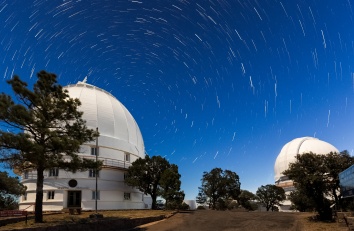McDonald Observatory is a research unit of The University of Texas at Austin and one of the world's leading centers for astronomical research, teaching, and public education and outreach. Observatory facilities are located atop Mount Locke and Mount Fowlkes in the Davis Mountains of West Texas, which offer some of the darkest night skies in the continental United States. Additionally, the observatory is a partner in the Giant Magellan Telescope under construction in Chile. McDonald's principal research telescopes include:
The Giant Magellan Telescope
The Giant Magellan Telescope (GMT) now under construction in Chile is the first in a new generation of extremely large telescopes. Its seven mirrors will span 25 meters. UT Austin is a founding partner in the collaboration which includes several other U.S. universities and partner institutions from around the world. The telescope is expected to see first light in the next decade. More information is available at the project website.
The Hobby-Eberly Telescope
With its 10-meter mirror, the HET is one of the world's largest optical telescopes. First dedicated in 1997, the telescope underwent a complete and extensive upgrade in 2017. The HET is optimized for spectroscopy, the decoding of light from stars and galaxies to study their properties. This makes it ideal for searching for planets around other stars, as well as probing distant galaxies, exploding stars, black holes, and more. This telescope is critical to a major study of dark energy, the Hobby-Eberly Telescope Dark Energy Experiment (HETDEX). The HET is a joint project of The University of Texas at Austin, The Pennsylvania State University, Ludwig-Maximilians-Universität München, and Georg-August-Universität Göttingen.
The Harlan J. Smith Telescope
Constructed 1966-68, the Smith Telescope has a 2.7-meter (107-inch) mirror, which was the third largest in the world when built. The telescope is used every clear night of the year.
The Otto Struve Telescope
Constructed 1933-39, the Struve Telescope was the first major telescope to be built at McDonald Observatory. Its 2.1-meter (82-inch) mirror was the second largest in the world at the time. The telescope is still in use today.
Other Telescopes
McDonald also operates several one-meter class telescopes. These include MONET/North, a node of the Las Cumbres Observatory Global Telescope Network, as well as 0.9-meter (36-inch) and 0.8-meter (30-inch) telescopes. Additionally, the Observatory is home to the 0.8-meter (30-inch) McDonald Laser Ranging Station operated by UT Austin's Center for Space Research, a 20-inch telescope operated by Boston University, and a 0.45-meter automated telescope that is part of the ROTSE collaboration.
Public Education and Outreach
McDonald Observatory operates a multi-faceted international public outreach program. At the on-site Frank N. Bash Visitors Center, outreach events include star parties, public tours, K-12 teacher and student activities, and more. McDonald also produces the StarDate radio program, StarDate magazine, the StarDate Online website, and special programs for hundreds of elementary and secondary teachers across the United States.


